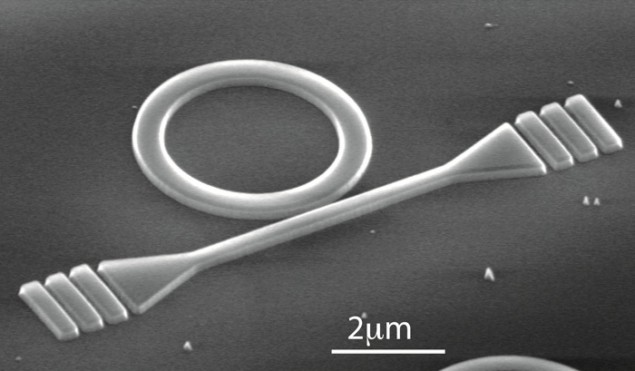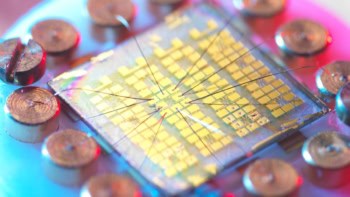
Physicists in the US are the first to make an integrated device that extracts photons from a tiny piece of diamond before the light is sent through a waveguide to the outside world. The photons all have the same frequency and originate in a nitrogen vacancy (NV), which is a defect that occurs in diamond when two neighbouring carbon atoms are replaced by a nitrogen atom and an empty lattice site. According to the researchers, the chip could be used to create quantum-information technology such as quantum repeaters.
For anyone trying to build a quantum computer NVs are useful because they have an electronic spin that is extremely well isolated from the surrounding lattice – so if an NV is placed in a certain spin state then it will remain in that state for ages, even at room temperature. An NV can also emit just a single photon if excited by a laser of the right wavelength. Taken together, these properties mean that NVs allow data to be stored for long times in a defect, before being read out as a single photon.
Researchers are particularly interested in extracting photons that do not interact with the surrounding lattice because these “zero phonon line” (ZPL) photons have a well defined frequency. Unfortunately, one challenge in building NV-based quantum systems is how to reliably get ZPL photons out of the diamond and into an integrated optical system, where it can be processed further. What Andrei Faraon and colleagues from Caltech, Hewlett Packard and the University of Washington have managed to do is to create an integrated optical system that does just that.
Matching frequencies
At the heart of their device is a ring of diamond that is just 4.5 μm in diameter and contains NV centres. The ring sits next to a waveguide that is about 10 μm long (see figure). The device is cooled to below 10K and the ring is scanned with a green laser until a NV centre with a resonant frequency close to that of the ring is located. The team then introduces a noble gas into the cryostat and some of it condenses on the ring – changing its resonant frequency. More gas is added until the frequencies of the NV centre and the ring exactly match.
The ZPL photons are created by firing the green laser at the NV centre. The photons first circulate around the ring before jumping into the wave guide. They then travel to either end of the waveguide, where a diffraction grating scatters them out of the device, where they can be observed with a microscope connected to a spectrometer and a photodetector.
The researchers found that they collected about 25 times more ZPL photons from these devices than were collected from NV centres in similar samples of diamond that were not part of integrated devices.
Faraon sees this work as an important step towards creating integrated circuits in which ZPL photons carry quantum information from one NV centre to another. “We demonstrate that photons – the information carriers – from a single NV centre can be coupled to an optical resonator and then further coupled to a photonic waveguide,” he says. “We hope that multiple devices of this kind will be interconnected in a photonic network on a chip.”
What Faraon and colleagues want to do now is to develop devices that include more than one NV centre and show that photons emitted by two NVs can be made to interfere – a pre-requisite for entangling NV centres. Once entanglement has been achieved, the devices could then be used as quantum repeaters, which absorb and re-emit entangled photons without disturbing the entangled state – something that is necessary if quantum information is to be transmitted over large distances. Faraon told physicsworld.com that his colleagues at Hewlett Packard are now working on entangling NV centres on the same chip.
The device is described in the New Journal of Physics.



